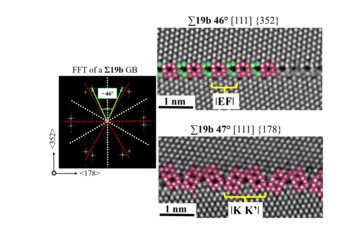All genres
161.
Talk
Spin-polarization-induced structural selectivity in substituted Laves phases. Workshop, Imst, Austria (2010)
162.
Talk
Computational study of interstitial ordering in bcc iron. Computational Materials Science on Complex Energy Landscapes Workshop, Imst, Austria (2010)
163.
Talk
First principles study of thermodynamic, structural and elastic properties of eutectic Ti-Fe alloys. Computational Materials Science on Complex Energy Landscapes Workshop, Imst, Austria (2010)
164.
Talk
Crustacean skeletal elements: Variations in the constructional morphology at different hierarchical levels. DFG Winter School Priotity Programme 1420: "Biomimetic Materials Research: Functionality by Hierarchical Structuring of Materials", Kerkrade, The Netherlands (2010)
165.
Talk
Ab initio study of calcite substituted by Mg and P. Seminar talk at Masaryk University, Brno, Czech Republic (2009)
166.
Talk
Ab initio study of calcite substituted by Mg and P. Multiscale design modeling 2009, Brno, Czech Republic (2009)
167.
Talk
Extremal stiffness of crustacean cuticle through hierarchical optimization: Theory, modeling, and experiment. 3rd International Conference on Mechanics of Biomaterials & Tissues, multiscale modeling of tissue mechanical properties, Clearwater Beach, FL, USA (2009)
168.
Talk
Ab initio Determined Fundamental Materials-design Limits in Mg–Li–X (X = Al, Si, Zn, Ca, Cu) Ternaries. Materials Research Society (MRS) meeting, Boston, MA, USA (2009)
169.
Talk
Theory-guided Design of Bone-matched Ti-based Multi-phase Biomaterials. Materials Research Society (MRS) meeting, Boston, MA, USA (2009)
170.
Talk
An atomistic study of martensitic phases in dilute Fe-based solid solutions. MRS Fall Meeting, Boston, MA, USA (2009)
171.
Talk
First-principles based multi-scale approaches to the elasticity of metallic polycrystals and hierarchical bio-composites. AICES meets MPIE workshop, Monschau, Germany (2009)
172.
Talk
Crustacean skeletal elements: Variations in the constructional morphology at different hierarchical levels. Seminar talk at Masaryk University, Brno, Czech Republic (2009)
173.
Talk
Ab Initio Determined Materials-Design Limits in Ultra Light-Weight Mg-Li Alloys. 8th International Conference on Magnesium Alloys and their Applications, Weimar, Germany (2009)
174.
Talk
Ab-initio based multi-scale approaches to the elasticity of metallic polycrystals and hierarchical biocomposites. ICAMS seminar, Bochum, Germany (2009)
175.
Talk
Ab-initio based multi-scale approaches to the elasticity of metallic polycrystals and hierarchical bio-composites. Bauhaus University Weimar, Weimar, Germany (2009)
176.
Talk
Multi-physical alloy approaches to solid solution strengthening of Al. 1st International Conference on Material Modelling, Dortmund, Germany (2009)
177.
Talk
Hierarchical modeling of the elastic properties of lobster cuticle via first principles calculations and mean-field homogenization. 1st International Conference on Material Modeling, Dortmund, Germany (2009)
178.
Talk
Theory Guided Design of Bcc Mg–Li Alloys for Ultra Light-Weight Applications. EUROMAT 2009, Glasgow, UK (2009)
179.
Talk
Investigation of solid solution strengthening by density functional theory. EUROMAT 2009, Glasgow, Scotland, UK (2009)
180.
Talk
Multi-Scale Hierarchical Modeling of the Mechanical Properties of Lobster Cuticle. EUROMAT 2009, Glasgow, UK (2009)











